语义学 蕴含与预设
- 格式:doc
- 大小:118.50 KB
- 文档页数:15
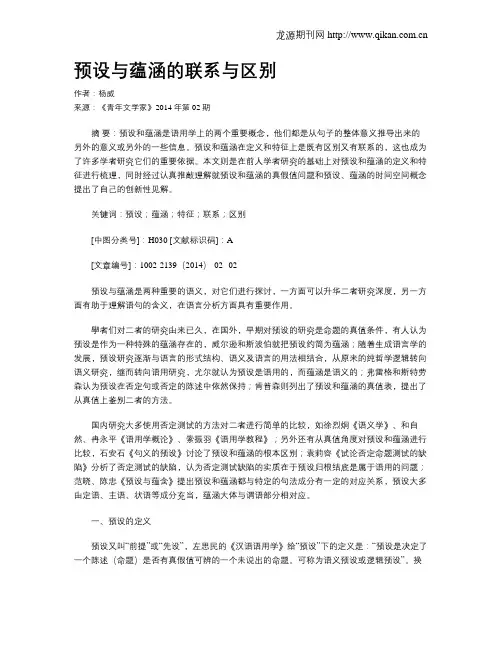
预设与蕴涵的联系与区别作者:杨威来源:《青年文学家》2014年第02期摘要:预设和蕴涵是语用学上的两个重要概念,他们都是从句子的整体意义推导出来的另外的意义或另外的一些信息。
预设和蕴涵在定义和特征上是既有区别又有联系的,这也成为了许多学者研究它们的重要依据。
本文则是在前人学者研究的基础上对预设和蕴涵的定义和特征进行梳理,同时经过认真推敲理解就预设和蕴涵的真假值问题和预设、蕴涵的时间空间概念提出了自己的创新性见解。
关键词:预设;蕴涵;特征;联系;区别[中图分类号]:H030 [文献标识码]:A[文章编号]:1002-2139(2014)-02--02预设与蕴涵是两种重要的语义,对它们进行探讨,一方面可以升华二者研究深度,另一方面有助于理解语句的含义,在语言分析方面具有重要作用。
學者们对二者的研究由来已久,在国外,早期对预设的研究是命题的真值条件,有人认为预设是作为一种特殊的蕴涵存在的,威尔逊和斯波伯就把预设约简为蕴涵;随着生成语言学的发展,预设研究逐渐与语言的形式结构、语义及语言的用法相结合,从原来的纯哲学逻辑转向语义研究,继而转向语用研究,尤尔就认为预设是语用的,而蕴涵是语义的;弗雷格和斯特劳森认为预设在否定句或否定的陈述中依然保持;肯普森则列出了预设和蕴涵的真值表,提出了从真值上鉴别二者的方法。
国内研究大多使用否定测试的方法对二者进行简单的比较,如徐烈炯《语义学》、和自然、冉永平《语用学概论》、索振羽《语用学教程》;另外还有从真值角度对预设和蕴涵进行比较,石安石《句义的预设》讨论了预设和蕴涵的根本区别;袁莉容《试论否定命题测试的缺陷》分析了否定测试的缺陷,认为否定测试缺陷的实质在于预设归根结底是属于语用的问题;范晓、陈忠《预设与蕴含》提出预设和蕴涵都与特定的句法成分有一定的对应关系,预设大多由定语、主语、状语等成分充当,蕴涵大体与谓语部分相对应。
一、预设的定义预设又叫“前提”或“先设”,左思民的《汉语语用学》给“预设”下的定义是:“预设是决定了一个陈述(命题)是否有真假值可辨的一个未说出的命题。
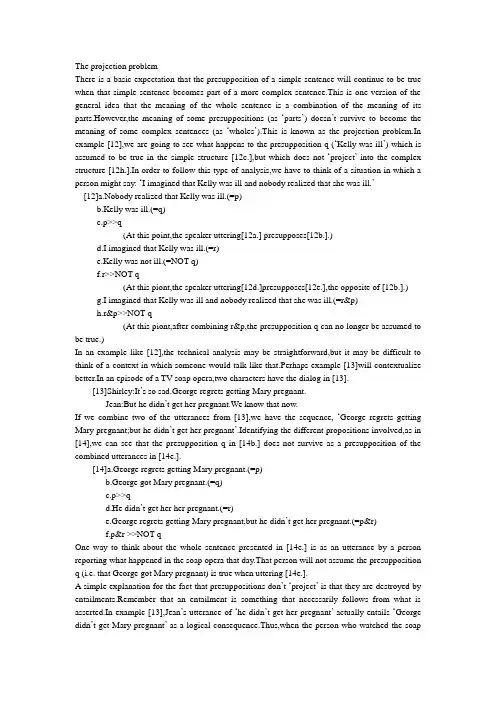
The projection problemThere is a basic expectation that the presupposition of a simple sentence will continue to be true when that simple sentence becomes part of a more complex sentence.This is one version of the general idea that the meaning of the whole sentence is a combination of the meaning of its parts.However,the meaning of some presuppositions (as ‘parts’) doesn’t survive to become the meaning of some complex sentences (as ‘wholes’).This is known as the projection problem.In example [12],we are going to see what happens to the presupposition q (‘Kelly was ill’) which is assumed to be true in the simple structure [12c.],but which does not ‘project’into the complex structure [12h.].In order to follow this type of analysis,we have to think of a situation in which a person might say: ‘I imagined that Kelly was ill and nobody realized that she was ill.’[12]a.Nobody realized that Kelly was ill.(=p)b.Kelly was ill.(=q)c.p>>q(At this point,the speaker uttering[12a.] presupposes[12b.].)d.I imagined that Kelly was ill.(=r)e.Kelly was not ill.(=NOT q)f.r>>NOT q(At this piont,the speaker uttering[12d.]presupposes[12e.],the opposite of [12b.].)g.I imagined that Kelly was ill and nobody realized that she was ill.(=r&p)h.r&p>>NOT q(At this piont,after combining r&p,the presupposition q can no longer be assumed to be true.)In an example like [12],the technical analysis may be straightforward,but it may be difficult to think of a context in which someone would talk like that.Perhaps example [13]will contextualize better.In an episode of a TV soap opera,two characters have the dialog in [13].[13]Shirley:It’s so sad.George regrets getting Mary pregnant.Jean:But he didn’t get her pregnant.We know that now.If we combine two of the utterances from [13],we have the sequence, ‘George regrets getting Mary pregnant;but he didn’t get her pregnant’.Identifying the different propositions involved,as in [14],we can see that the presupposition q in [14b.] does not survive as a presupposition of the combined utterances in [14e.].[14]a.George regrets getting Mary pregnant.(=p)b.George got Mary pregnant.(=q)c.p>>qd.He didn’t get her her pregnant.(=r)e.George regrets getting Mary pregnant,but he didn’t get her pregnant.(=p&r)f.p&r >>NOT qOne way to think about the whole sentence presented in [14e.] is as an utterance by a person reporting what happened in the soap opera that day.That person will not assume the presupposition q (i.e. that George got Mary pregnant) is true when uttering [14e.].A simple explanation for the fact that presuppositions don’t ‘project’ is that they are destroyed by entailments.Remember that an entailment is something that necessarily follows from what is asserted.In example [13],Jean’s utterance of ‘he didn’t get her pregnant’ actually entails ‘George didn’t get Mary pregnant’ as a logical consequence.Thus,when the person who watched the soapopera tells you that ‘George regrets getting Mary pregnant,but he didn’t get her pregnant’,you have a presupposition q and an entailment NOT q.The entailment (a necessary consequence of what is said) is simply more powerful than the presupposition (an earlier assumption).The power of entailment can also be used to cancel exastential presuppositions.Normally we assume that when a person uses a definite description of the type ‘the X’ (for example, ‘the King of England’),he or she presupposes the existence of the entity described,as in the utterance of [15a.].Also,in any utterance of the form ‘X doesn’t exist’,as in [15b.],there is an entailment that there is no X..But does the speaker of [15b.] also still have the presupposition of the existence of the entity described?[15]a.The King of England visired us.b.The King of England doesn’t exist!Instead of thinking that a speaker who utters [15b.] simultaneously believes that there is a King of England (=presupposition) and that there is not a King of England (=entailment),we recognize that the entailment is more powerful than the presupposition.We abandon the existential presupposition.As already emphasized,it may be best to think of all the types of presuppositions illustrated in Table 4.1 as ‘potential presuppositions’ which only become actual presuppositions when intended by speakers to be recognized as such within utterances.Speakers can indeed indicate that the potential presupposition is not being presented as a strong assumption.Possessive constructions such as ‘his car’have a potential presupposition (i.e. he has a car) which can be presented tentatively via expressions such as ‘or something’,as in [16].[16]a.What’s that guy doing in the parking lot?b.He’s looking for his car or something.In [16b.],the speaker is not committed to the presupposition (he has a car) as an assumed fact.It is worth remembering that it is never the word or phrase that has a presupposition.Only speakers can have presuppositions.Ordered entailmentsGenerally speaking,entailment is not a pragmatic concept (i.e.having to do with speaker meaning),but instead is considered a purely logical concept,symbolized by‖-.Some examples of entailment for the sentence in [17] are presented in [18].[17]Rover chased three squirrels.(=p)[18]a.Something chased three squirrels.(=q)b.Rover did something to three squittels.(=r)c.Rover chased three of something.(=s)d.Something happened.(=t)In representing the relationship of entailment between [17] and [18a.] as p‖- q,we have simply symbolized a logical concequence.Let us say that in uttering the sentence in [17],the speaker is necessarily committed to the truth of a very large number of background entailments (only some of which are presented in [18a.-d.]).On any occasion of utterance [17],however,the spaeker willindicate how these entailments are to be ordered.That is,the speaker will communicate,typically by stress,which entailment is assumed to be in the foreground,or more important for interpreting intended meaning,than any others.For example,in uttering [19a.],the speaker indicates that the foreground entailment,and hence her main assumption,is that Rover chased a certain number of squirrels.[19]a.Rover chased THREE squirrels.b.ROVER chased three squirrels.In [19b.],the focus shifts to Rover,and the main assumption is that something chased three squirrels.One function of stress in English is,in this approach,clearly tied to marking the main assumption of the speaker in producing an utterance.As such,it allows the speaker to mark for the listener what the focus of the message is,and what is being assumed.A very similar function is exhibited by a structure called an ‘itcleft’construction in English,as shown in [20].[20]a.It was ROVER that chased the squirrels.b.It wasn’t ME who took your money.In both examples in [20],the speaker can communicate what he or she believes the listener may already be thinking (i.e.the foreground entailment).In [20b.] that foreground entailment (someone took your money) is being made the shared knowledge in order for the denial of personal responsibility to be made.The utterance in [20b.] can be used to attribute the foreground entailment to the listener(s) without actually stating it (for example,as a possible accusation).It is one more example of more being communicated than is said.。
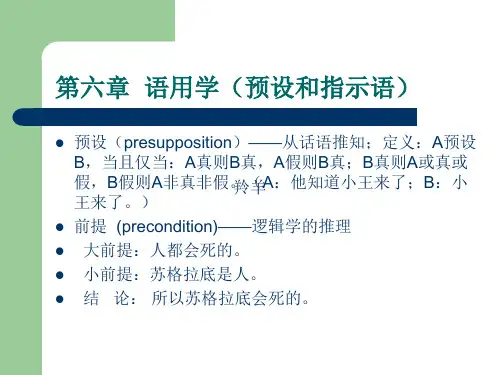
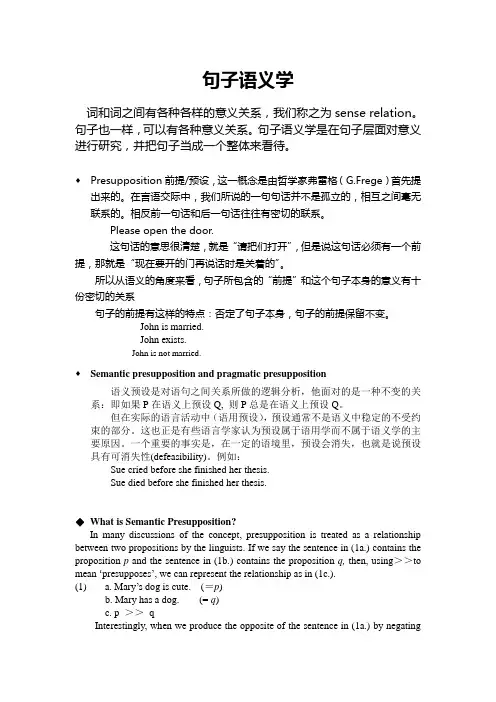
句子语义学词和词之间有各种各样的意义关系,我们称之为sense relation。
句子也一样,可以有各种意义关系。
句子语义学是在句子层面对意义进行研究,并把句子当成一个整体来看待。
◆Presupposition前提/预设,这一概念是由哲学家弗雷格(G.Frege)首先提出来的。
在言语交际中,我们所说的一句句话并不是孤立的,相互之间毫无联系的。
相反前一句话和后一句话往往有密切的联系。
Please open the door.这句话的意思很清楚,就是“请把们打开”,但是说这句话必须有一个前提,那就是“现在要开的门再说话时是关着的”。
所以从语义的角度来看,句子所包含的“前提”和这个句子本身的意义有十份密切的关系句子的前提有这样的特点:否定了句子本身,句子的前提保留不变。
John is married.John exists.John is not married.◆Semantic presupposition and pragmatic presupposition语义预设是对语句之间关系所做的逻辑分析,他面对的是一种不变的关系:即如果P在语义上预设Q, 则P总是在语义上预设Q。
但在实际的语言活动中(语用预设),预设通常不是语义中稳定的不受约束的部分。
这也正是有些语言学家认为预设属于语用学而不属于语义学的主要原因。
一个重要的事实是,在一定的语境里,预设会消失,也就是说预设具有可消失性(defeasibility)。
例如:Sue cried before she finished her thesis.Sue died before she finished her thesis.◆What is Semantic Presupposition?In many discussions of the concept, presupposition is treated as a relationship between two propositions by the linguists. If we say the sentence in (1a.) contains the proposition p and the sentence in (1b.) contains the proposition q, then, using>>to mean …presupposes‟, we can represent the relationship as in (1c.).(1) a. Mary‟s dog is cute. (=p)b. Mary has a dog. (= q)c. p >>qInterestingly, when we produce the opposite of the sentence in (1a.) by negating it (= NOT p), as in (2a.), we find that the relationship of presupposition does not change. That is, the same proposition q, repeated as (2b.), continues to be presupposedby NOT p, as shown in (2c.).(2) a. Mary‟s dog isn‟t cute. (=NOT p)b. Mary has a dog. (= q)c. NOT p >>qPresupposition is an inference(推论)to the proposition of the sentence. Take the following sentences for example again:e.g. (3) John is married.(4) John exists.(5) John is not married.Comment: if (3) is true, (4) is true; if (3) is not true, (4) is still true. In this case, we can say both (3) and (5) presuppose (4). A presupposition is something the speaker assumes to be the case prior to making an utterance. Speakers, not sentences, have presuppositions. An entailment is something that logically follows from what is asserted in the utterance. Sentences, not speakers, have entailments.◆Semantic presupposition would be based on the following definition:Sentence A semantically presupposes another sentence B iff:if and only if, iff是充分必要条件(a) in all situations where A is true, B is true(b) in all situations where A is false, B is true◆Types of presuppositionPotential presupposition: in the analysis of how speakers‟ assumptions are typically expressed, presupposition has been associated with the use of a large number of words, phrases, and structures. These linguistic forms shall be considered as indicators of potential presuppositions, which can only become actual presuppositions in contexts with speakers. The following kinds of presuppositions are all potential presuppositions. Now we‟ll look at the major presupposition types marked by different linguistic features.◆Existential presupposition: presuppose the existence of something.(my). It is not only assumed to be present in possessive constructions, but more generally in any definite descriptions such as definite noun phrase with determines …the‟, …this‟, …that‟, …these‟, …those‟, etc. By using any of the expressions in (16), the speaker is assumed to be committed to the existence of the entities named.(16) e.g. The king of Sweden, the cat, the girl next door (Yule, 2004: 27)◆Factive presupposition: presuppose something as a fact.(know). A number of factive verbs, such as …realize‟in (17a) and …regret‟in (17b), as well as phrases involving …be‟ with …aware‟ in (17c), …odd‟ in (17d), and …glad‟ in (17e) have factive presuppositions.(17) a. She didn‟t realize he was ill.(>>He was ill)b. We regret telling him.(>>We told him)c. I wasn‟t aware that she was married.(>>She was married)d. It isn‟t odd that he left early.(>>He left early)e. I‟m glad that it‟s over.(>>It‟s over)The presupposed information following the verb …know‟ can be treated as a fac t, and is described as a factive presupposition. Words like know, realize, regret as well as phrases involving …be‟ with …aware‟, …odd‟, and …glad‟ have factive presuppositions. (Yule, 2004: 27-28)◆Lexical presupposition: when a specific word triggers a presupposition. It is featured by implicative verbs like …manage‟, …start‟, …stop‟, …forget‟, etc. Generally speaking, in lexical presupposition, the use of one form with its asserted meaning is conventionally interpreted with the presupposition that another (non-asserted) meaning is understood.Each time you say that someone …managed‟to do something, the asserted meaning is that the person succeeded in some way. When you say that someone …didn‟t manage‟, the asserted meaning is that the person did not succeed. In both cases, however, there is a presupposition (non-asserted) that the person …tried‟to do that something. So, …managed‟ is conventionally interpreted as asserting …succeeded‟ and presupposing …tried‟.(18) a. He stopped smoking.(>>He used to smoke)b. They started complaining.(>>They weren‟t complaining before)c. You‟re late again.(>>You were late before)Lexical presupposition: in lexical presupposition, the use of one form with its asserted meaning is conventionally interpreted with the presupposition that another(non-asserted) meaning is understood. For example, someone …managed‟ to do something, the asserted meaning is that the person succeeded in some way. Someone …didn‟t manage‟; the asserted meaning is that the person did not succeed. In both cases, there is a presupposition (non-asserted) that the person …tried‟ to do that something. So …managed‟is conventionally interpreted as asserting …succeeded‟ and presupposing …tried‟. Other examples, involving the lexical items, are …stop‟, …start‟, and …again‟. (Yule, 2004: 28)◆Structural presupposition: certain sentence structures presuppose something to be true.(wh-questions). We might say that speakers can use such structures to treat information as presupposed (i.e. assumed to be true) and hence to be accepted as true by the listener.For example, the wh-question construction in English, as shown in (19a) and (19b), is conventionally interpreted with the presupposition that the information after the wh-form is already known to be the case.a. When did he leave?(>>He left)b. Where did you buy the bike?(>>You bought the bike)Certain sentence structures have been analyzed as conventionally and regularly presupposing that part of the structure is already assumed to be true. We might say that speakers can use such structures to treat information as presupposed (i.e. assumed to be true) and hence to be accepted as true by listener. For example, the wh-question construction in English is conventionally interpreted as that the information after the wh-form is already known to be the case. Such structurally-based presuppositions may represent subtle ways of making information that the speaker believes appear to be what the listener should believe.(wh-questions)◆Non-factive presupposition: It is one that is assumed not to be true. Verbs like …dream‟, …imagine‟, and …pretend‟, as shown in (20), are used with the presupposition that what follows is not true.(20). a. I dreamed that I was rich.(>>I was not rich)b. We imagined we were in New York.(>>we were not in New York)He pretends to be ill.(>>He is not ill)◆Counter-factural presupposition: What is presupposed is not only not true, but is the opposite of what is true, or …contrary to facts‟. (Conditional structure)A conditional structure of the type shown in (21), generally called a counterfactual conditional, presupposes that the information in the if-clause is not true at the time of utterance.(21). If you were my friend, you would have helped me.(>>you are not my friend)Summary:◆The properties of presuppositions★Cancel ability / Defeasibility:Levinson(1983:186) states that they can be cancelled out by either the immediate linguistic context or by some wider context or mode of discourse. If we say …The committee failed to reach a decision‟, it presupposes that they tried, but we can cancel out that presupposition if we add …because they didn‟t even get round to discussing it‟. Similarly, we can argue presupposition out of the way by a variant on the reductio ad absurdum (the disproof of a proposition by showing that its conclusion can only be absurd) mode of discourse: …He didn‟t do it, and she didn‟t do it…In fact, nobody did it ‟. They are defensible in (a) certain discourse contexts, (b) certain intra-sentential context. This property will prove to be the undoing(doing away with) of any possible semantic theory of presupposition. They are defeasible in certain intra-sentential contexts and certain discourse context, for example,(1) Sue cried before she finished her thesis.(2) Sue finished her thesis.(3)Sue died before she finished her thesis.In Sentence(3) the presupposition seems to drop out, since we generally hold that people do not do things after they die, it follows that she could not have finished her thesis. They are liable to evaporate in certain contexts, either immediate linguistic context or the less immediate discourse context, or on circumstances where contrary assumptions are made.(Levinson,2001, p187)Another kind of contextual defeasibility arises in certain kinds of discourse contexts. For example, the cleft sentence 1 is supposed to presuppose 2:1. It isn‟t Luke who will betray you.2. Someone will betray you.You say that someon e in this room will betray you. Well maybe so. But it won‟t be Luke who will betray you, it won‟t be Paul, it won‟t be Matthew, and it certainly won‟t be John. Therefore no one in this room is actually going to betray youHere each of the cleft sentence(It won‟t be Luke, etc.)should presuppose that there will be someone who will betray the addressee. But the whole purpose of the utterance 1 is, of course, to persuade the addressee that no one will betray him, as stated in the conclusion. So the presupposition is again defeated; it was adopted as a counterfactual assumption to argue to the untenability (站不住脚) of such an assumption.So far we have shown that some of the core examples of presuppositional phenomena are subject to presupposition cancellation in certain kinds of context, namely:(i)Where it is common knowledge that the presupposition is false, the speaker is not assumed to be committedto the truth of the presupposition(ii) Where what is said, taken together with background assumptions, is inconsistent with what is presupposed, the presuppositions are cancelled, and are not assumed to be held by the speaker(iii) In certain kinds of discourse contexts, presuppositions can systematically fail to survive.3.4.2 Presuppositions are apparently tied to particular aspects of surface structure. This property may serve to distinguish presupposition from conversational implicatures (which are tied to the context rather than the surface structure.), the other major form of pragmatic inference.( Levinson, S. C. 2001)There are no doubt many other kinds of contextual defeasibility as well, but these examples are sufficient to establish that presuppositions are defeasible by virtue of contrary beliefs held in a context. There are also many kinds of intra-sentential cancellation of suspension of presuppositions.(Levinson, 190)3.4.3 Projection in presupposition There is a basic expectation that the presupposition of a simple sentence will continue to be true when that simple sentence becomes part of a more complex sentence. This is one version of the general idea that the meaning of the whole sentence is a combination of the meaning of its parts. However, the meaning of some presuppositions (as …parts‟) does not survive to become the meaning of some complex sentences (as …wholes‟). This is known as the projection problem. (Yule, 2004: P30-33) Another explanation given by Levinson (Levinson, 1983: 191) is that Frege held that meanings of sentences are compositional, i.e. that the meaning of the whole expression is a function of the meaning of the parts. It was originally suggested by Langendoen & Savin (1971) that this was true of presuppositions too, and moreover that the set of presupposition of the complex whole is the simple sum of the presuppositions of the parts, i.e. if S0 is a complex sentence containing sentences S1, S2…S n as constituents, then the presuppositions of S0 = the presuppositions of S1 + the presuppositions of S2 …+ the presuppositions of S n .But such a simple solution to the presuppositions of complex sentences is far from correct, and it has proved in fact extremely difficult to formulate a theory that will predict correctly which presuppositions of component clauses will in fact be inherited/maintained by the complex whole. This compositional problem is known as the projection problem for presuppositions, and the particular behaviour of presuppositions in complex sentences turns out to be the really distinctive characteristic of presuppositions. (The Chinese version may be a little easier to understand:详见索振羽,《语用学教程》2000.北京大学出版社P136-140)◆Presupposition triggers: Some of the kinds of words and structures that seem to trigger presuppositions. Definite noun phrase/definite descriptions: words like the, this, that, these, those and possessives like my, Mary’s, your, prepositional phrase like with(two heads), in, etc. trigger the basic kind of presupposition. The possessives lead to a particularly strong presupposition about the existence of something; this is sometimes called existential presupposition. (Peccei, p20)John saw/didn‟t see the man with two heads.》there exists a man with two headsWH-words like when, why, how, etc. used either to ask questions or to introduce a subordinate clause to trigger the presupposition that the speaker has assumed “the person in question did something” is true. (Peccei, p 21)Mr. Givens, why is it important for people to understand body language---that is, communication by means of movements and gestures?Where do we get mannerisms such as these?Verbs that can trigger presuppositions: implicative verbs, factive verbs, change of state verbs and verbs of judging.1) Implicative verbs(含蓄动词): manage, forget, happen, avoid etc. triggers the presupposition that some actions were conducted(manage), not expected(happen), or should have been conducted(forget).John managed/didn‟t manage to open the door》John tried to open the doorJohn forg ot /didn‟t forget to lock the door》John ought to have locked, or intended to lock, the doorsome further implicative predicates: X happened to V 》X didn‟t plan or intend to V; X avoid Ving 》X was expected to, or usually did, or ought to V2) factive verbs(述实动词/事实动词a verb followed by a clause which the speaker or writer considers to expressa fact:know, realize, regret, deplore(谴责), I am aware, it is strange, it is odd that, be sorry that, be proud that, be indifferent that, be glad that, be sad that, etc. triggers the presupposition that what follows is a fact。
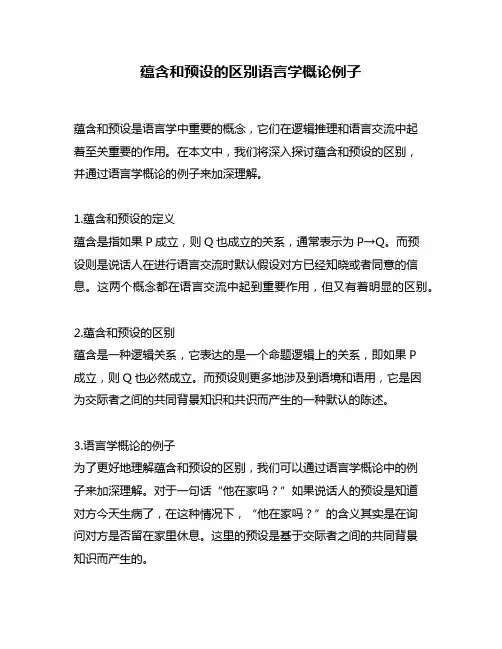
蕴含和预设的区别语言学概论例子蕴含和预设是语言学中重要的概念,它们在逻辑推理和语言交流中起着至关重要的作用。
在本文中,我们将深入探讨蕴含和预设的区别,并通过语言学概论的例子来加深理解。
1.蕴含和预设的定义蕴含是指如果P成立,则Q也成立的关系,通常表示为P→Q。
而预设则是说话人在进行语言交流时默认假设对方已经知晓或者同意的信息。
这两个概念都在语言交流中起到重要作用,但又有着明显的区别。
2.蕴含和预设的区别蕴含是一种逻辑关系,它表达的是一个命题逻辑上的关系,即如果P成立,则Q也必然成立。
而预设则更多地涉及到语境和语用,它是因为交际者之间的共同背景知识和共识而产生的一种默认的陈述。
3.语言学概论的例子为了更好地理解蕴含和预设的区别,我们可以通过语言学概论中的例子来加深理解。
对于一句话“他在家吗?”如果说话人的预设是知道对方今天生病了,在这种情况下,“他在家吗?”的含义其实是在询问对方是否留在家里休息。
这里的预设是基于交际者之间的共同背景知识而产生的。
而如果我们考虑蕴含的例子,可以想象一个逻辑推理的情景,比如“如果今天下雨,那么明天会很湿”。
这里的蕴含关系在逻辑上是成立的,即如果今天下雨,则明天会很湿。
这和预设的例子有着明显的区别,前者更多地涉及到逻辑推理,后者则更多地涉及到语境和语用。
4.个人观点和理解对于蕴含和预设的区别,我个人认为它们在语言交流中都是至关重要的概念。
蕴含关系帮助我们在逻辑推理和论证中建立起合乎逻辑的关系,而预设则帮助我们在语言交流中更好地理解对方的意图和表达。
在实际的交际中,我们经常会遇到预设的情况,了解和理解预设的存在对于沟通的顺利进行至关重要。
总结回顾通过本文的探讨,我们深入理解了蕴含和预设的区别,并通过语言学概论的例子加深了对这两个概念的理解。
蕴含和预设在语言学中都具有重要的地位,它们帮助我们更好地进行逻辑推理和语言交流,促进了有效的交际和沟通。
在知识的文章格式中,我们可以使用序号标注来更清晰地表达观点和例子,从而帮助读者更好地理解和接受文章内容。
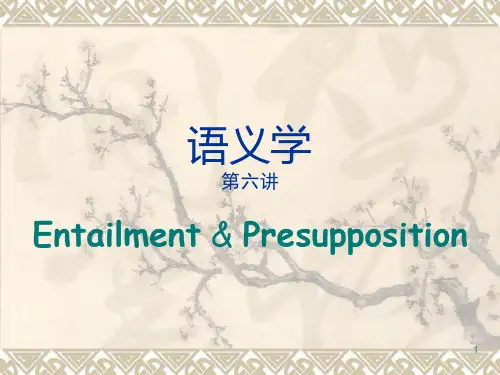
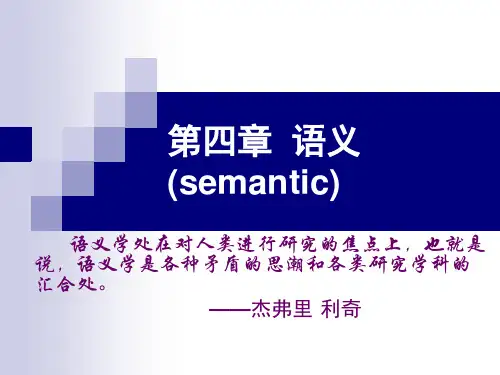
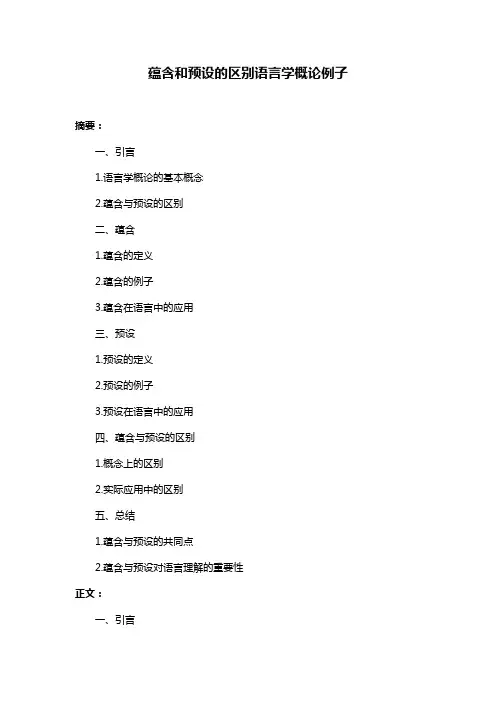
蕴含和预设的区别语言学概论例子摘要:一、引言1.语言学概论的基本概念2.蕴含与预设的区别二、蕴含1.蕴含的定义2.蕴含的例子3.蕴含在语言中的应用三、预设1.预设的定义2.预设的例子3.预设在语言中的应用四、蕴含与预设的区别1.概念上的区别2.实际应用中的区别五、总结1.蕴含与预设的共同点2.蕴含与预设对语言理解的重要性正文:一、引言语言学概论作为语言学的基础理论,研究的是语言的本质、结构、功能和演变。
在语言学的学习过程中,蕴含和预设是两个重要的概念,它们在语言中起着至关重要的作用。
然而,很多人对这两个概念的区别并不十分清楚。
本文将对蕴含和预设进行详细的阐述,以便读者更好地理解这两个概念。
二、蕴含1.定义蕴含,又称内在意义,是指一个句子中词汇和语法结构所隐含的信息。
简单来说,蕴含是说话者通过语言表达,听话者能够推断出来的意义。
2.例子例句1:小明喜欢吃苹果。
这句话的蕴含是:小明可能还喜欢吃其他水果。
例句2:他去上学了。
这句话的蕴含是:他现在不在家里。
3.在语言中的应用蕴含是语言中的一种重要现象,它可以帮助我们更有效地进行沟通。
通过蕴含,我们可以传递更多的信息,使对方更容易理解我们的意图。
三、预设1.定义预设,又称前提,是指一个句子中说话者和听话者共同默认的一个事实或信念。
预设通常是不需要明确说出的,但却对理解句子至关重要。
2.例子例句1:小明喜欢吃苹果。
这句话的预设是:小明是一个人。
例句2:他去上学了。
这句话的预设是:他是一个学生。
3.在语言中的应用预设是语言中的一种普遍现象,它可以帮助我们更快速地理解句子,提高沟通效率。
预设通常基于人们共同的知识、经验和文化背景。
四、蕴含与预设的区别1.概念上的区别蕴含是指句子中隐含的信息,而预设是指句子中说话者和听话者共同默认的事实或信念。
这两者之间的区别在于,蕴含是语言表达中可以推断出的意义,而预设是理解句子所必需的前提。
2.实际应用中的区别在实际应用中,蕴含和预设经常同时出现。

《蕴含和预设的区别——语言学概论》1. 概述在语言学中,蕴含和预设是两个非常重要的概念,它们在语言表达和交流中扮演着重要的角色。
本文将从蕴含和预设的定义开始,逐步深入探讨它们的区别,并结合语言学概论的例子,帮助读者更好地理解这两个概念。
2. 蕴含的定义和例子蕴含是指从一个陈述中可以推导出另一个陈述的关系。
当我们说“如果今天下雨,那么路上会很滑”。
这句话蕴含了“如果路上很滑,那么今天下雨了”。
蕴含是一种逻辑上的推理关系,它可以帮助我们理解语言表达的进一步含义。
3. 预设的定义和例子预设是指说话者在交流时假定对方已经了解或者同意的信息。
当我们说“我又换了新无线终端”,就预设了对方已经知道我们之前有一部无线终端。
预设是语言交际中常见的现象,它可以帮助说话者简化语言表达,同时也涉及到说话者和听话者之间的交流默契。
4. 蕴含与预设的区别蕴含和预设虽然都涉及到语言表达中的额外含义,但它们之间存在着明显的区别。
蕴含是逻辑上的推理关系,是从一个陈述推导出另一个陈述;而预设是说话者在交流中假定对方已经了解的信息。
在实际语言交际中,我们常常会同时运用蕴含和预设,以达到更准确、简洁的表达。
5. 语言学概论中的例子在语言学概论中,蕴含和预设也有着丰富的例子。
在语义学中,我们经常通过分析词语之间的蕴含关系来理解其含义的丰富性;而在语用学中,预设则涉及到说话者和听话者之间的认知和交流模式。
通过深入研究语言学概论中的例子,我们可以更好地理解蕴含和预设在语言学中的实际运用。
6. 总结与回顾通过对蕴含和预设的区别以及语言学概论中的例子的探讨,我们可以清晰地理解这两个概念在语言表达和交流中的重要性。
蕴含和预设不仅帮助人们更准确地理解语言表达的含义,同时也反映了语言交际中的复杂性和多样性。
深入理解蕴含和预设,有助于我们更好地掌握语言学的基本知识,同时也丰富了我们对语言交际的认识。
7. 个人观点和理解在我看来,蕴含和预设是语言学中非常有趣和重要的概念。
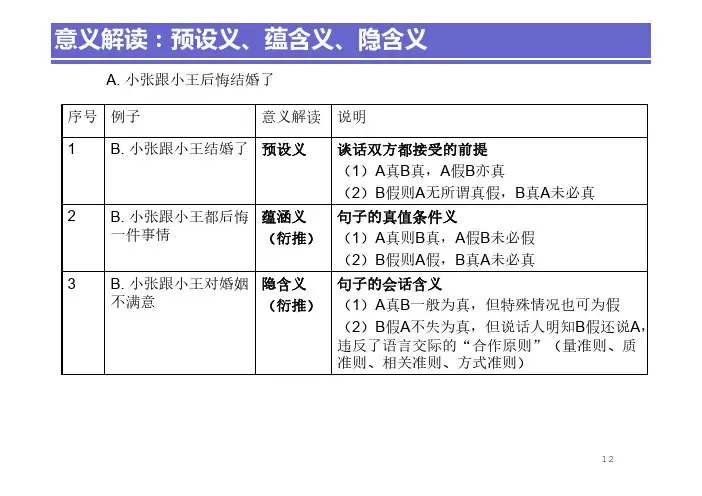
语义知识描述的复杂性(1)命题义(超常论元结构)(2)模态(情态)义(3)羡余否定(4)语义指向(5)名词指称义(6)代词指代义(7)焦点义(8)构式义(9)隐喻义(10)句际关系义1 过去他是铁饭碗,干一天是十块钱,不干也是十块钱2 他是猪肉馅儿,我是牛肉馅儿(1)命题义(超常论元结构)5 张三跟李四比赛吃玻璃⏹否定语境⏹超常现象3 张三不可能吃思想4 张三怎么可能吃思想6 布尔毕达哥拉斯三元数问题:从1到7824的任何整数能够被染成红色或蓝色,使得满足a^2 + b^2 = c^2 的三个整数a、b、c不全是同一种颜色;而对于从1到7825的整数,不存在满足条件的染色。
⏹假想世界⏹成分省略(2)模态(情态)义1.小张连打了三个喷嚏,感冒了吧。
2.他搞不好已经毕业了。
3.看样子他很有经验。
4.他保证已经毕业了。
5.他能熟练使用两种语言。
6.这次会议能使用两种语言。
7.我能骗你吗?猜测、存疑认定猜测、相信能力许可可能(3)羡余否定1.在问题没有解决之前= 在问题解决之前2.在考试没有结束之前= 在考试结束之前3.年轻人难免不犯错误= 年轻人难免犯错误4.当时差点儿没吓死= 当时差点儿吓死5.天冷,小心别着凉= 天冷,小心着凉6.他们宿舍好不热闹= 他们宿舍好热闹(4)语义指向1.从小爷爷就教育我要诚实。
2.当时那孩子就稀里糊涂判给了男方。
3.今年我和他先后去过广州和福州。
4.老张看着很无奈(5)名词指称义1.这人升了大官了。
2.这人都爱往高处走。
3.在北大图书馆自习室,你找不到一个玩游戏的学生。
4.在美国的大众新闻媒体机构中, 人们找不到一个持社会主义观点的新闻工作者或政治评论家。
5.区块链技术:“有一个人有仲裁权”是集中式系统,还是分布式系统?6.一个计划生育宣传者说到世界上的人口问题的严重性时说“A womanwill have a baby every three minutes”。
有听众就问:“Why don’t we find her and stop her?”(6)代词指代义1. 一个男人临死前对siri说,tell my wife, I love her.于是,他妻子的手机收到了一条来自丈夫手机的短信:I love her.2. 航站导航员:“请报告你的高度、位置。
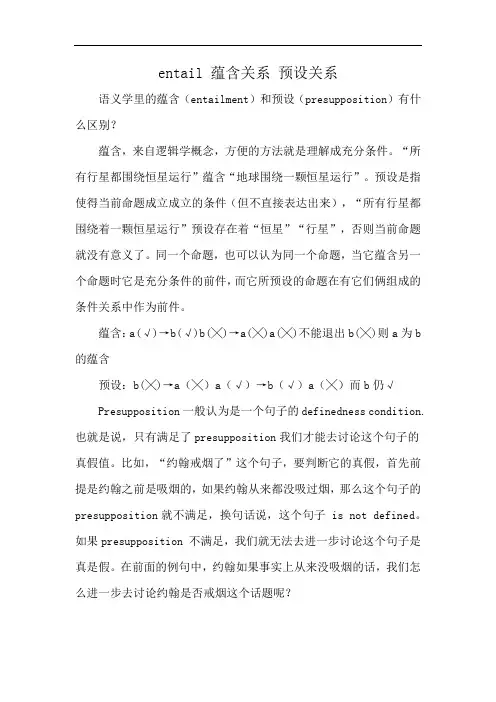
entail 蕴含关系预设关系
语义学里的蕴含(entailment)和预设(presupposition)有什么区别?
蕴含,来自逻辑学概念,方便的方法就是理解成充分条件。
“所有行星都围绕恒星运行”蕴含“地球围绕一颗恒星运行”。
预设是指使得当前命题成立成立的条件(但不直接表达出来),“所有行星都围绕着一颗恒星运行”预设存在着“恒星”“行星”,否则当前命题就没有意义了。
同一个命题,也可以认为同一个命题,当它蕴含另一个命题时它是充分条件的前件,而它所预设的命题在有它们俩组成的条件关系中作为前件。
蕴含:a(√)→b(√)b(╳)→a(╳)a(╳)不能退出b(╳)则a为b 的蕴含
预设:b(╳)→a(╳)a(√)→b(√)a(╳)而b仍√
Presupposition一般认为是一个句子的definedness condition. 也就是说,只有满足了presupposition我们才能去讨论这个句子的
真假值。
比如,“约翰戒烟了”这个句子,要判断它的真假,首先前提是约翰之前是吸烟的,如果约翰从来都没吸过烟,那么这个句子的presupposition就不满足,换句话说,这个句子 is not defined。
如果presupposition 不满足,我们就无法去进一步讨论这个句子是真是假。
在前面的例句中,约翰如果事实上从来没吸烟的话,我们怎么进一步去讨论约翰是否戒烟这个话题呢?
而entailment是由一个句子的assertion引出的inference,比如“约翰住在巴黎”这个句子,如果约翰住在巴黎的话,我们就能推出“约翰住在法国”。
“约翰住在法国”就是“约翰住在巴黎的”一个 entailment。
句子语义学词和词之间有各种各样的意义关系,我们称之为sense relation。
句子也一样,可以有各种意义关系。
句子语义学是在句子层面对意义进行研究,并把句子当成一个整体来看待。
◆Presupposition前提/预设,这一概念是由哲学家弗雷格(G.Frege)首先提出来的。
在言语交际中,我们所说的一句句话并不是孤立的,相互之间毫无联系的。
相反前一句话和后一句话往往有密切的联系。
Please open the door.这句话的意思很清楚,就是“请把们打开”,但是说这句话必须有一个前提,那就是“现在要开的门再说话时是关着的”。
所以从语义的角度来看,句子所包含的“前提”和这个句子本身的意义有十份密切的关系句子的前提有这样的特点:否定了句子本身,句子的前提保留不变。
John is married.John exists.John is not married.◆Semantic presupposition and pragmatic presupposition语义预设是对语句之间关系所做的逻辑分析,他面对的是一种不变的关系:即如果P在语义上预设Q, 则P总是在语义上预设Q。
但在实际的语言活动中(语用预设),预设通常不是语义中稳定的不受约束的部分。
这也正是有些语言学家认为预设属于语用学而不属于语义学的主要原因。
一个重要的事实是,在一定的语境里,预设会消失,也就是说预设具有可消失性(defeasibility)。
例如:Sue cried before she finished her thesis.Sue died before she finished her thesis.◆What is Semantic Presupposition?In many discussions of the concept, presupposition is treated as a relationship between two propositions by the linguists. If we say the sentence in (1a.) contains the proposition p and the sentence in (1b.) contains the proposition q, then, using>>to mean ‘presupposes’, we can represent the relationship as in (1c.).(1) a. Mary’s dog is cute. (=p)b. Mary has a dog. (= q)c. p >>qInterestingly, when we produce the opposite of the sentence in (1a.) by negating it (= NOT p), as in (2a.), we find that the relationship of presupposition does not change. That is, the same proposition q, repeated as (2b.), continues to be presupposedby NOT p, as shown in (2c.).(2) a. Mary’s dog isn’t cute. (=NOT p)b. Mary has a dog. (= q)c. NOT p >>qPresupposition is an inference(推论)to the proposition of the sentence. Take the following sentences for example again:e.g. (3) John is married.(4) John exists.(5) John is not married.Comment: if (3) is true, (4) is true; if (3) is not true, (4) is still true. In this case, we can say both (3) and (5) presuppose (4). A presupposition is something the speaker assumes to be the case prior to making an utterance. Speakers, not sentences, have presuppositions. An entailment is something that logically follows from what is asserted in the utterance. Sentences, not speakers, have entailments.◆Semantic presupposition would be based on the following definition:Sentence A semantically presupposes another sentence B iff:if and only if, iff是充分必要条件(a) in all situations where A is true, B is true(b) in all situations where A is false, B is true◆Types of presuppositionPotential presupposition: in the analysis of how speakers’ assumptions are typically expressed, presupposition has been associated with the use of a large number of words, phrases, and structures. These linguistic forms shall be considered as indicators of potential presuppositions, which can only become actual presuppositions in contexts with speakers. The following kinds of presuppositions are all potential presuppositions. Now we’ll look at the major presupposition types marked by different linguistic features.◆Existential presupposition: presuppose the existence of something.(my). It is not only assumed to be present in possessive constructions, but more generally in any definite descriptions such as definite noun phrase with determines ‘the’, ‘this’, ‘that’, ‘these’, ‘those’, etc. By using any of the expressions in (16), the speaker is assumed to be committed to the existence of the entities named.(16) e.g. The king of Sweden, the cat, the girl next door (Yule, 2004: 27)◆Factive presupposition: presuppose something as a fact.(know). A number of factive verbs, such as ‘realize’in (17a) and ‘regret’in (17b), as well as phrases involving ‘be’ with ‘aware’ in (17c), ‘odd’ in (17d), and ‘glad’ in (17e) have factive presuppositions.(17) a. She didn’t realize he was ill.(>>He was ill)b. We regret telling him.(>>We told him)c. I wasn’t aware that she was married.(>>She was married)d. It isn’t odd that he left early.(>>He left early)e. I’m glad that it’s over.(>>It’s over)The presupposed information following the verb ‘know’ can be treated as a fac t, and is described as a factive presupposition. Words like know, realize, regret as well as phrases involving ‘be’ with ‘aware’, ‘odd’, and ‘glad’ have factive presuppositions. (Yule, 2004: 27-28)◆Lexical presupposition: when a specific word triggers a presupposition. It is featured by implicative verbs like ‘manage’, ‘start’, ‘stop’, ‘forget’, etc. Generally speaking, in lexical presupposition, the use of one form with its asserted meaning is conventionally interpreted with the presupposition that another (non-asserted) meaning is understood.Each time you say that someone ‘managed’to do something, the asserted meaning is that the person succeeded in some way. When you say that someone ‘didn’t manage’, the asserted meaning is that the person did not succeed. In both cases, however, there is a presupposition (non-asserted) that the person ‘tried’to do that something. So, ‘managed’ is conventionally interpreted as asserting ‘succeeded’ and presupposing ‘tried’.(18) a. He stopped smoking.(>>He used to smoke)b. They started complaining.(>>They weren’t complaining before)c. You’re late again.(>>You were late before)Lexical presupposition: in lexical presupposition, the use of one form with its asserted meaning is conventionally interpreted with the presupposition that another(non-asserted) meaning is understood. For example, someone ‘managed’ to do something, the asserted meaning is that the person succeeded in some way. Someone ‘didn’t manage’; the asserted meaning is that the person did not succeed. In both cases, there is a presupposition (non-asserted) that the person ‘tried’ to do that something. So ‘managed’is conventionally interpreted as asserting ‘succeeded’ and presupposing ‘tried’. Other examples, involving the lexical items, are ‘stop’, ‘start’, and ‘again’. (Yule, 2004: 28)◆Structural presupposition: certain sentence structures presuppose something to be true.(wh-questions). We might say that speakers can use such structures to treat information as presupposed (i.e. assumed to be true) and hence to be accepted as true by the listener.For example, the wh-question construction in English, as shown in (19a) and (19b), is conventionally interpreted with the presupposition that the information after the wh-form is already known to be the case.a. When did he leave?(>>He left)b. Where did you buy the bike?(>>You bought the bike)Certain sentence structures have been analyzed as conventionally and regularly presupposing that part of the structure is already assumed to be true. We might say that speakers can use such structures to treat information as presupposed (i.e. assumed to be true) and hence to be accepted as true by listener. For example, the wh-question construction in English is conventionally interpreted as that the information after the wh-form is already known to be the case. Such structurally-based presuppositions may represent subtle ways of making information that the speaker believes appear to be what the listener should believe.(wh-questions)◆Non-factive presupposition: It is one that is assumed not to be true. Verbs like ‘dream’, ‘imagine’, and ‘pretend’, as shown in (20), are used with the presupposition that what follows is not true.(20). a. I dreamed that I was rich.(>>I was not rich)b. We imagined we were in New York.(>>we were not in New York)He pretends to be ill.(>>He is not ill)◆Counter-factural presupposition: What is presupposed is not only not true, but is the opposite of what is true, or ‘contrary to facts’. (Conditional structure)A conditional structure of the type shown in (21), generally called a counterfactual conditional, presupposes that the information in the if-clause is not true at the time of utterance.(21). If you were my friend, you would have helped me.(>>you are not my friend)Summary:◆The properties of presuppositions★Cancel ability / Defeasibility:Levinson(1983:186) states that they can be cancelled out by either the immediate linguistic context or by some wider context or mode of discourse. If we say ‘The committee failed to reach a decision’, it presupposes that they tried, but we can cancel out that presupposition if we add ‘because they didn’t even get round to discussing it’. Similarly, we can argue presupposition out of the way by a variant on the reductio ad absurdum (the disproof of a proposition by showing that its conclusion can only be absurd) mode of discourse: ‘He didn’t do it, and she didn’t do it…In fact, nobody did it ’. They are defensible in (a) certain discourse contexts, (b) certain intra-sentential context. This property will prove to be the undoing(doing away with) of any possible semantic theory of presupposition. They are defeasible in certain intra-sentential contexts and certain discourse context, for example,(1) Sue cried before she finished her thesis.(2) Sue finished her thesis.(3)Sue died before she finished her thesis.In Sentence(3) the presupposition seems to drop out, since we generally hold that people do not do things after they die, it follows that she could not have finished her thesis. They are liable to evaporate in certain contexts, either immediate linguistic context or the less immediate discourse context, or on circumstances where contrary assumptions are made.(Levinson,2001, p187)Another kind of contextual defeasibility arises in certain kinds of discourse contexts. For example, the cleft sentence 1 is supposed to presuppose 2:1. It isn’t Luke who will betray you.2. Someone will betray you.You say that someon e in this room will betray you. Well maybe so. But it won’t be Luke who will betray you, it won’t be Paul, it won’t be Matthew, and it certainly won’t be John. Therefore no one in this room is actually going to betray youHere each of the cleft sentence(It won’t be Luke, etc.)should presuppose that there will be someone who will betray the addressee. But the whole purpose of the utterance 1 is, of course, to persuade the addressee that no one will betray him, as stated in the conclusion. So the presupposition is again defeated; it was adopted as a counterfactual assumption to argue to the untenability (站不住脚) of such an assumption.So far we have shown that some of the core examples of presuppositional phenomena are subject to presupposition cancellation in certain kinds of context, namely:(i)Where it is common knowledge that the presupposition is false, the speaker is not assumed to be committedto the truth of the presupposition(ii) Where what is said, taken together with background assumptions, is inconsistent with what is presupposed, the presuppositions are cancelled, and are not assumed to be held by the speaker(iii) In certain kinds of discourse contexts, presuppositions can systematically fail to survive.3.4.2 Presuppositions are apparently tied to particular aspects of surface structure. This property may serve to distinguish presupposition from conversational implicatures (which are tied to the context rather than the surface structure.), the other major form of pragmatic inference.( Levinson, S. C. 2001)There are no doubt many other kinds of contextual defeasibility as well, but these examples are sufficient to establish that presuppositions are defeasible by virtue of contrary beliefs held in a context. There are also many kinds of intra-sentential cancellation of suspension of presuppositions.(Levinson, 190)3.4.3 Projection in presupposition There is a basic expectation that the presupposition of a simple sentence will continue to be true when that simple sentence becomes part of a more complex sentence. This is one version of the general idea that the meaning of the whole sentence is a combination of the meaning of its parts. However, the meaning of some presuppositions (as ‘parts’) does not survive to become the meaning of some complex sentences (as ‘wholes’). This is known as the projection problem. (Yule, 2004: P30-33) Another explanation given by Levinson (Levinson, 1983: 191) is that Frege held that meanings of sentences are compositional, i.e. that the meaning of the whole expression is a function of the meaning of the parts. It was originally suggested by Langendoen & Savin (1971) that this was true of presuppositions too, and moreover that the set of presupposition of the complex whole is the simple sum of the presuppositions of the parts, i.e. if S0 is a complex sentence containing sentences S1, S2…S n as constituents, then the presuppositions of S0 = the presuppositions of S1 + the presuppositions of S2 …+ the presuppositions of S n .But such a simple solution to the presuppositions of complex sentences is far from correct, and it has proved in fact extremely difficult to formulate a theory that will predict correctly which presuppositions of component clauses will in fact be inherited/maintained by the complex whole. This compositional problem is known as the projection problem for presuppositions, and the particular behaviour of presuppositions in complex sentences turns out to be the really distinctive characteristic of presuppositions. (The Chinese version may be a little easier to understand:详见索振羽,《语用学教程》2000.北京大学出版社P136-140)◆Presupposition triggers: Some of the kinds of words and structures that seem to trigger presuppositions. Definite noun phrase/definite descriptions: words like the, this, that, these, those and possessives like my, Mary’s, your, prepositional phrase like with(two heads), in, etc. trigger the basic kind of presupposition. The possessives lead to a particularly strong presupposition about the existence of something; this is sometimes called existential presupposition. (Peccei, p20)John saw/didn’t see the man with two heads.》there exists a man with two headsWH-words like when, why, how, etc. used either to ask questions or to introduce a subordinate clause to trigger the presupposition that the speaker has assumed “the person in question did something” is true. (Peccei, p 21)Mr. Givens, why is it important for people to understand body language---that is, communication by means of movements and gestures?Where do we get mannerisms such as these?Verbs that can trigger presuppositions: implicative verbs, factive verbs, change of state verbs and verbs of judging.1) Implicative verbs(含蓄动词): manage, forget, happen, avoid etc. triggers the presupposition that some actions were conducted(manage), not expected(happen), or should have been conducted(forget).John managed/didn’t manage to open the door》John tried to open the doorJohn forg ot /didn’t forget to lock the door》John ought to have locked, or intended to lock, the doorsome further implicative predicates: X happened to V 》X didn’t plan or intend to V; X avoid Ving 》X was expected to, or usually did, or ought to V2) factive verbs(述实动词/事实动词a verb followed by a clause which the speaker or writer considers to expressa fact:know, realize, regret, deplore(谴责), I am aware, it is strange, it is odd that, be sorry that, be proud that, be indifferent that, be glad that, be sad that, etc. triggers the presupposition that what follows is a fact。
㈡预设 1)定义:就话语本⾝表达的意义⽽⾔,通过背景知识断⾔有句义甲就必然有句义⼄就是说甲以⼄为预设。
2)预设和蕴含区别: ①蕴含在句⼦的断⾔范围之内,是句⼦的基本信息; ②预设不在句⼦的断⾔范围之内,是句⼦的背景信息。
3)预设对⾔语表达和理解的影响:避免重复罗嗦。
6.歧义 1)定义:指同⼀形式的语⾔符号序列可能表达不同意义的现象。
2)歧义以语⾔符号序列的同形为前提条件。
3)歧义与模糊的区别: ①模糊指语⾔形式所反映的对象只有⼀个⼤致的范围,⽽没有明确的界限,意义之间难以绝对划分清楚。
歧义指同形的语⾔符号中具有两个或两个以上不同的意义。
②在⾔语交际中,歧义可以通过上下⽂语境和情景语境来消除。
⽽模糊始终是模糊的。
4)歧义与笼统性区别: ①统来源于语义的概括性特点是指对同类对象的不同成员进⾏抽象概括⽽产⽣的。
②歧义来源于语义和表达形式之间的⽭盾。
5)影响歧义难度的因素: ①与各种解释的相对频率有关系 ②与歧义形式本⾝的特点有关系。
6)歧义的类型:①词汇歧义②组合歧义 备注:㈠词汇歧义:指由词汇上的原因造成的歧义。
词语的同⾳异义可能造成⼝头歧义。
词语的同形异义也可能造成歧义。
词语的⼀词多义也可能造成歧义。
㈡组合歧义: 1)定义:指由词语组合关系上的原因造成的歧义。
2)分类:①语法结构歧义②语义结构歧义 (三)如果相同的词语之间可以有不同的句法结构关系,就有可能造成歧义。
如果相同的词语之间可以有不同的层次构造,也有可能造成歧义。
如果相同的词语之间可以有不同的语义结构关系,就有可能造成歧义。
摘要预设和蕴含有着一定的联系,不易区别开来。
对于预设和蕴含,弗雷格、罗素、斯特劳森等都有所论及。
本文旨在区别预设和蕴含,并探讨预设只涉及语句的名词性成分,而蕴含与所陈述的命题有关。
且预设不是语句中固定不变的,不受语境制约的成分,它是可消除的。
而蕴含是一种纯逻辑推理,具有不可消除性。
蕴含是语句中信息的一部分,而预设则是信息的背景。
Abstract: Presupposition has so many relations with entailment that the subtle distinctions between them become the barrier to some scholars. The arguments of Frege, Russell and others represent the hard study process of the problems above. The thesis distinguishes between the presupposition and the entailment from many viewpoints. It argues that the presuppositions only relate to the nominal elements in a sentence, but the entailments to the proposition of a statement. And it says that the presupposition can be defeasible because ifits being ungoverned by context, while the entailment just is a pure logical reasoning. Taking the theory of Grice into account, the thesis author thinks that the entailment is a part of the information of a sentence, but the presupposition is the background of the information.所谓蕴含,是指下列命题关系:在所有情况下P 为真,Q也为真时,那么P蕴含Q。
自考复习资料:语言学概论第五章第四节第四节句义一、句义的构成1.句子的语言意义2.词汇意义:词是句子的基本构成部分,句子中词的意义也就成为句义的重要组成部分。
理解一个句子的意义,首先要懂得句中词语的词汇意义。
3.关系意义:句子通常都是由词语组合而成的,词语在组合时总要形成必然的结构关系,由这些结构关系所赋予的意义就是我们所说的关系意义。
词语之间的关系意义可分为语法关系意义和语义关系意义。
4.词汇意义和关系意义的区别:词汇意义是词语本身所具有的意义,一个词语即使孤立存在,也会具有必然的词汇意义,而关系意义则是词语进入组合之中才产生的意义,它只存在于必然的句法结构之中,孤立的词语是没有关系意义的。
5.语法关系意义:词语在必然的语法结构中形成的彼此关系就是语法结构关系,由这种结构关系所赋予的意义就是语法关系意义。
6.语义关系意义:语义结构关系是指词语在组合中产生的语义上的关系,它是必然的现实关系的概括反映,由这种结构关系所赋予的意义就是语义关系意义。
如“猴子吃桃子”所包含的语法关系意义有“猴子”和“吃桃子”之间的“陈述”的意义和“吃”与“桃子”之间的“涉及”的意义,而这句话所包含的语义关系意义有:“吃”和“猴子”之间存在的“动作”和“施事”的意义和“吃”和“桃子”之间的“动作”和“受事”的意义。
7.语气意义:反映说话人使用句子的目的和说话人情绪的意义就是语气意义。
语气意义包罗陈述、疑问、祈使、感叹等不同的意义。
在语言中可以通过语调、虚词和语气副词等形式表达。
二、句子的语义结构1.述谓结构:由-个谓词和若干个变元组成,谓词是处于支配地位的核心部分。
一个述谓结构可以有多少变元以及有何种性质的变元,都是由谓词的语义规定的。
2.变元:又称题元、项等,是与谓词有直接语义关系并受谓词支配的语义成分,一般都是名词性的词语,在句子中经常充当主语或宾语。
3.语义角色:按照谓词和变元之间的不同语义关系,可以把变元分为若干类型,这种变元的类型一般称为语义角色。
蕴含和预设的区别语言学概论例子
摘要:
1.蕴含和预设的定义
2.语言学概论中的例子
3.蕴含和预设的区别
正文:
1.蕴含和预设的定义
蕴含和预设是语义学中的两个重要概念。
蕴含指的是一个句子或语句表达的真值条件,即当句子为真时,其所表达的事实或命题的真实情况。
预设则是指在特定语境下,一个句子或语句所暗示或暗含的意义或信息。
2.语言学概论中的例子
在《语言学概论》这本书中,作者通过一些例子来解释蕴含和预设的区别。
例如,句子“张三吃了一个苹果”蕴含的信息是张三吃东西,而预设的信息是张三吃了一个苹果,这个苹果是可食用的,张三有吃东西的能力等。
3.蕴含和预设的区别
蕴含和预设的区别主要体现在以下几个方面:
首先,蕴含是语句自身的意义,是句子的真值条件。
而预设则是句子在特定语境下的暗含意义,是句子的背景知识。
其次,蕴含是逻辑上的关系,是对事实的陈述。
而预设则是心理上的关系,是对信息的暗示。
最后,蕴含是语义学的核心概念,而预设则是语用学的核心概念。
蕴含关
注的是句子自身的意义,而预设关注的是句子在交际中的使用。
总的来说,蕴含和预设的区别主要在于它们的定义、性质和功能。
浅议语义预设及语用的预设1、预设理论简介Frege最早讨论预设问题 ,他说 :当我们说到“月亮”时 ,我们预设了该指称的存在。
当今当今西方语言学界对预设有一种常见定义 ,是通过与“蕴涵”相区别而给出的。
所谓蕴是一个语句的逻辑后果 ,而预设则是一个话语的前提条件。
Kempson总结过蕴涵与预设的别: A蕴涵 B,则当且仅当:A 真B必真 ,A假 B可真可假 ,B假 A必假;A预设 B,则当且仅当 :A真B必真,A 假B亦真,B假A可真可假。
例如:“张三不再爱李四”蕴涵“张三现在不爱李四”并且预设“张三曾经爱李四”。
Levinson则直接利用“蕴涵”概念给出了这样一个定义: A预设了B,则当且仅当:A蕴涵了B,并且非A也蕴涵了 B。
试以 Russell给出的一个着名例子为例: “The King of France is wise.”(A)蕴涵了“There is a present king of France.”(B),前者矛盾命题“The King of France is not wise.”(非A)同样蕴含了“There is a p resent king of France.” (B)。
从以上的论述可以看出,预设具有这样一个根本特征:即使在否定命题下,预设仍保持为一个常值。
2、语义预设语义预设的基础理论预设的语义研究始于英国着名哲学家斯特劳逊,他在《逻辑理论导论》(1952)一书中对预设进行了如下定义:“一个命题S预设S’,而且仅当S’是S有真值或假值的必要条件。
”语义学领域的预设是建立在真值条件语义理论(truth -conditional semantics)的基础上的。
如:(1a) Mark’s father bought him a book.(1b) Mark has a father.在真值条件语义逻辑下 ,这两句话的真实性关系可以描述为 :如果 (1a)是真实 (true)的,则(1b)是真实 (true)的 ;如果 (1a)是虚假(false)的 ,则 (1b)还是真实 (true)的 ;如果(1b)是真实 (true)的, 则 (1a)是真实 (true)或虚假 (false)的。
句子语义学词和词之间有各种各样的意义关系,我们称之为sense relation。
句子也一样,可以有各种意义关系。
句子语义学是在句子层面对意义进行研究,并把句子当成一个整体来看待。
◆Presupposition前提/预设,这一概念是由哲学家弗雷格(G.Frege)首先提出来的。
在言语交际中,我们所说的一句句话并不是孤立的,相互之间毫无联系的。
相反前一句话和后一句话往往有密切的联系。
Please open the door.这句话的意思很清楚,就是“请把们打开”,但是说这句话必须有一个前提,那就是“现在要开的门再说话时是关着的”。
所以从语义的角度来看,句子所包含的“前提”和这个句子本身的意义有十份密切的关系句子的前提有这样的特点:否定了句子本身,句子的前提保留不变。
John is married.John exists.John is not married.◆Semantic presupposition and pragmatic presupposition语义预设是对语句之间关系所做的逻辑分析,他面对的是一种不变的关系:即如果P在语义上预设Q, 则P总是在语义上预设Q。
但在实际的语言活动中(语用预设),预设通常不是语义中稳定的不受约束的部分。
这也正是有些语言学家认为预设属于语用学而不属于语义学的主要原因。
一个重要的事实是,在一定的语境里,预设会消失,也就是说预设具有可消失性(defeasibility)。
例如:Sue cried before she finished her thesis.Sue died before she finished her thesis.◆What is Semantic Presupposition?In many discussions of the concept, presupposition is treated as a relationship between two propositions by the linguists. If we say the sentence in (1a.) contains the proposition p and the sentence in (1b.) contains the proposition q, then, using>>to mean …presupposes‟, we can represent the relationship as in (1c.).(1) a. Mary‟s dog is cute. (=p)b. Mary has a dog. (= q)c. p >>qInterestingly, when we produce the opposite of the sentence in (1a.) by negating it (= NOT p), as in (2a.), we find that the relationship of presupposition does not change. That is, the same proposition q, repeated as (2b.), continues to be presupposedby NOT p, as shown in (2c.).(2) a. Mary‟s dog isn‟t cute. (=NOT p)b. Mary has a dog. (= q)c. NOT p >>qPresupposition is an inference(推论)to the proposition of the sentence. Take the following sentences for example again:e.g. (3) John is married.(4) John exists.(5) John is not married.Comment: if (3) is true, (4) is true; if (3) is not true, (4) is still true. In this case, we can say both (3) and (5) presuppose (4). A presupposition is something the speaker assumes to be the case prior to making an utterance. Speakers, not sentences, have presuppositions. An entailment is something that logically follows from what is asserted in the utterance. Sentences, not speakers, have entailments.◆Semantic presupposition would be based on the following definition:Sentence A semantically presupposes another sentence B iff:if and only if, iff是充分必要条件(a) in all situations where A is true, B is true(b) in all situations where A is false, B is true◆Types of presuppositionPotential presupposition: in the analysis of how speakers‟ assumptions are typically expressed, presupposition has been associated with the use of a large number of words, phrases, and structures. These linguistic forms shall be considered as indicators of potential presuppositions, which can only become actual presuppositions in contexts with speakers. The following kinds of presuppositions are all potential presuppositions. Now we‟ll look at the major presupposition types marked by different linguistic features.◆Existential presupposition: presuppose the existence of something.(my). It is not only assumed to be present in possessive constructions, but more generally in any definite descriptions such as definite noun phrase with determines …the‟, …this‟, …that‟, …these‟, …those‟, etc. By using any of the expressions in (16), the speaker is assumed to be committed to the existence of the entities named.(16) e.g. The king of Sweden, the cat, the girl next door (Yule, 2004: 27)◆Factive presupposition: presuppose something as a fact.(know). A number of factive verbs, such as …realize‟in (17a) and …regret‟in (17b), as well as phrases involving …be‟ with …aware‟ in (17c), …odd‟ in (17d), and …glad‟ in (17e) have factive presuppositions.(17) a. She didn‟t realize he was ill.(>>He was ill)b. We regret telling him.(>>We told him)c. I wasn‟t aware that she was married.(>>She was married)d. It isn‟t odd that he left early.(>>He left early)e. I‟m glad that it‟s over.(>>It‟s over)The presupposed information following the verb …know‟ can be treated as a fac t, and is described as a factive presupposition. Words like know, realize, regret as well as phrases involving …be‟ with …aware‟, …odd‟, and …glad‟ have factive presuppositions. (Yule, 2004: 27-28)◆Lexical presupposition: when a specific word triggers a presupposition. It is featured by implicative verbs like …manage‟, …start‟, …stop‟, …forget‟, etc. Generally speaking, in lexical presupposition, the use of one form with its asserted meaning is conventionally interpreted with the presupposition that another (non-asserted) meaning is understood.Each time you say that someone …managed‟to do something, the asserted meaning is that the person succeeded in some way. When you say that someone …didn‟t manage‟, the asserted meaning is that the person did not succeed. In both cases, however, there is a presupposition (non-asserted) that the person …tried‟to do that something. So, …managed‟ is conventionally interpreted as asserting …succeeded‟ and presupposing …tried‟.(18) a. He stopped smoking.(>>He used to smoke)b. They started complaining.(>>They weren‟t complaining before)c. You‟re late again.(>>You were late before)Lexical presupposition: in lexical presupposition, the use of one form with its asserted meaning is conventionally interpreted with the presupposition that another(non-asserted) meaning is understood. For example, someone …managed‟ to do something, the asserted meaning is that the person succeeded in some way. Someone …didn‟t manage‟; the asserted meaning is that the person did not succeed. In both cases, there is a presupposition (non-asserted) that the person …tried‟ to do that something. So …managed‟is conventionally interpreted as asserting …succeeded‟ and presupposing …tried‟. Other examples, involving the lexical items, are …stop‟, …start‟, and …again‟. (Yule, 2004: 28)◆Structural presupposition: certain sentence structures presuppose something to be true.(wh-questions). We might say that speakers can use such structures to treat information as presupposed (i.e. assumed to be true) and hence to be accepted as true by the listener.For example, the wh-question construction in English, as shown in (19a) and (19b), is conventionally interpreted with the presupposition that the information after the wh-form is already known to be the case.a. When did he leave?(>>He left)b. Where did you buy the bike?(>>You bought the bike)Certain sentence structures have been analyzed as conventionally and regularly presupposing that part of the structure is already assumed to be true. We might say that speakers can use such structures to treat information as presupposed (i.e. assumed to be true) and hence to be accepted as true by listener. For example, the wh-question construction in English is conventionally interpreted as that the information after the wh-form is already known to be the case. Such structurally-based presuppositions may represent subtle ways of making information that the speaker believes appear to be what the listener should believe.(wh-questions)◆Non-factive presupposition: It is one that is assumed not to be true. Verbs like …dream‟, …imagine‟, and …pretend‟, as shown in (20), are used with the presupposition that what follows is not true.(20). a. I dreamed that I was rich.(>>I was not rich)b. We imagined we were in New York.(>>we were not in New York)He pretends to be ill.(>>He is not ill)◆Counter-factural presupposition: What is presupposed is not only not true, but is the opposite of what is true, or …contrary to facts‟. (Conditional structure)A conditional structure of the type shown in (21), generally called a counterfactual conditional, presupposes that the information in the if-clause is not true at the time of utterance.(21). If you were my friend, you would have helped me.(>>you are not my friend)Summary:◆The properties of presuppositions★Cancel ability / Defeasibility:Levinson(1983:186) states that they can be cancelled out by either the immediate linguistic context or by some wider context or mode of discourse. If we say …The committee failed to reach a decision‟, it presupposes that they tried, but we can cancel out that presupposition if we add …because they didn‟t even get round to discussing it‟. Similarly, we can argue presupposition out of the way by a variant on the reductio ad absurdum (the disproof of a proposition by showing that its conclusion can only be absurd) mode of discourse: …He didn‟t do it, and she didn‟t do it…In fact, nobody did it ‟. They are defensible in (a) certain discourse contexts, (b) certain intra-sentential context. This property will prove to be the undoing(doing away with) of any possible semantic theory of presupposition. They are defeasible in certain intra-sentential contexts and certain discourse context, for example,(1) Sue cried before she finished her thesis.(2) Sue finished her thesis.(3)Sue died before she finished her thesis.In Sentence(3) the presupposition seems to drop out, since we generally hold that people do not do things after they die, it follows that she could not have finished her thesis. They are liable to evaporate in certain contexts, either immediate linguistic context or the less immediate discourse context, or on circumstances where contrary assumptions are made.(Levinson,2001, p187)Another kind of contextual defeasibility arises in certain kinds of discourse contexts. For example, the cleft sentence 1 is supposed to presuppose 2:1. It isn‟t Luke who will betray you.2. Someone will betray you.You say that someon e in this room will betray you. Well maybe so. But it won‟t be Luke who will betray you, it won‟t be Paul, it won‟t be Matthew, and it certainly won‟t be John. Therefore no one in this room is actually going to betray youHere each of the cleft sentence(It won‟t be Luke, etc.)should presuppose that there will be someone who will betray the addressee. But the whole purpose of the utterance 1 is, of course, to persuade the addressee that no one will betray him, as stated in the conclusion. So the presupposition is again defeated; it was adopted as a counterfactual assumption to argue to the untenability (站不住脚) of such an assumption.So far we have shown that some of the core examples of presuppositional phenomena are subject to presupposition cancellation in certain kinds of context, namely:(i)Where it is common knowledge that the presupposition is false, the speaker is not assumed to be committedto the truth of the presupposition(ii) Where what is said, taken together with background assumptions, is inconsistent with what is presupposed, the presuppositions are cancelled, and are not assumed to be held by the speaker(iii) In certain kinds of discourse contexts, presuppositions can systematically fail to survive.3.4.2 Presuppositions are apparently tied to particular aspects of surface structure. This property may serve to distinguish presupposition from conversational implicatures (which are tied to the context rather than the surface structure.), the other major form of pragmatic inference.( Levinson, S. C. 2001)There are no doubt many other kinds of contextual defeasibility as well, but these examples are sufficient to establish that presuppositions are defeasible by virtue of contrary beliefs held in a context. There are also many kinds of intra-sentential cancellation of suspension of presuppositions.(Levinson, 190)3.4.3 Projection in presupposition There is a basic expectation that the presupposition of a simple sentence will continue to be true when that simple sentence becomes part of a more complex sentence. This is one version of the general idea that the meaning of the whole sentence is a combination of the meaning of its parts. However, the meaning of some presuppositions (as …parts‟) does not survive to become the meaning of some complex sentences (as …wholes‟). This is known as the projection problem. (Yule, 2004: P30-33) Another explanation given by Levinson (Levinson, 1983: 191) is that Frege held that meanings of sentences are compositional, i.e. that the meaning of the whole expression is a function of the meaning of the parts. It was originally suggested by Langendoen & Savin (1971) that this was true of presuppositions too, and moreover that the set of presupposition of the complex whole is the simple sum of the presuppositions of the parts, i.e. if S0 is a complex sentence containing sentences S1, S2…S n as constituents, then the presuppositions of S0 = the presuppositions of S1 + the presuppositions of S2 …+ the presuppositions of S n .But such a simple solution to the presuppositions of complex sentences is far from correct, and it has proved in fact extremely difficult to formulate a theory that will predict correctly which presuppositions of component clauses will in fact be inherited/maintained by the complex whole. This compositional problem is known as the projection problem for presuppositions, and the particular behaviour of presuppositions in complex sentences turns out to be the really distinctive characteristic of presuppositions. (The Chinese version may be a little easier to understand:详见索振羽,《语用学教程》2000.北京大学出版社P136-140)◆Presupposition triggers: Some of the kinds of words and structures that seem to trigger presuppositions. Definite noun phrase/definite descriptions: words like the, this, that, these, those and possessives like my, Mary’s, your, prepositional phrase like with(two heads), in, etc. trigger the basic kind of presupposition. The possessives lead to a particularly strong presupposition about the existence of something; this is sometimes called existential presupposition. (Peccei, p20)John saw/didn‟t see the man with two heads.》there exists a man with two headsWH-words like when, why, how, etc. used either to ask questions or to introduce a subordinate clause to trigger the presupposition that the speaker has assumed “the person in question did something” is true. (Peccei, p 21)Mr. Givens, why is it important for people to understand body language---that is, communication by means of movements and gestures?Where do we get mannerisms such as these?Verbs that can trigger presuppositions: implicative verbs, factive verbs, change of state verbs and verbs of judging.1) Implicative verbs(含蓄动词): manage, forget, happen, avoid etc. triggers the presupposition that some actions were conducted(manage), not expected(happen), or should have been conducted(forget).John managed/didn‟t manage to open the door》John tried to open the doorJohn forg ot /didn‟t forget to lock the door》John ought to have locked, or intended to lock, the doorsome further implicative predicates: X happened to V 》X didn‟t plan or intend to V; X avoid Ving 》X was expected to, or usually did, or ought to V2) factive verbs(述实动词/事实动词a verb followed by a clause which the speaker or writer considers to expressa fact:know, realize, regret, deplore(谴责), I am aware, it is strange, it is odd that, be sorry that, be proud that, be indifferent that, be glad that, be sad that, etc. triggers the presupposition that what follows is a fact。